Table of Contents
- INVICTUS CINEMATOGRAPHY ANALYSIS
- Essay 1: ‘Despite the fears of others, Mandela’s vision for something new achieves great change.’ Discuss.
- Essay 2 : ‘I am the master of my fate/ I am the captain of my soul’. What does the film suggest about the impact an individual’s conviction can have on external forces?
- Essay 3 : ‘Eastwood uses minor characters to demonstrate Mandela’s true impact.’ Discuss.
- Essay 4: Mandela tells his daughter Zindzi, “you criticize without understanding. You seek only to address your own feelings. This is selfish thinking.” ‘Invictus explores the idea that leaders must be the examples of change they wish to see’. Discuss.
- Essay 5: Winning the World Cup represents more than a sporting victory in Invictus. Discuss.
- Essay 6: Eastwood uses the film Invictus to demonstrate that the similarities between Pienaar and Mandela are more important than their differences. Discuss.
- Essay 7 : ’The film explores how South Africa comes to feel pride.’ To what extent do you agree?
- Essay 8 : Invictus demonstrates that revenge will not help wrongs to be made right. Discuss.
INVICTUS CINEMATOGRAPHY ANALYSIS
The opening scene


Invictus’ opening scenes juxtapose the difference in socio-economic and cultural identities of the racially segregated south African society. These two vastly different settings and environments/ people and sports are taken with one camera shot, without any cuts. This single camera shot emphasises the paradox that the two different South African communities share physical proximity/ are close to each other in terms of physical space, yet are worlds away in terms of their values and beliefs.
The security guards waiting outside Mandela’s house to escort him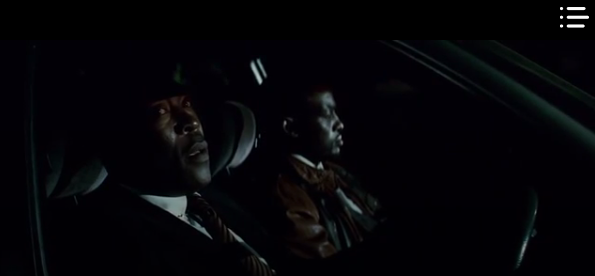
*The security guards converse and comment how Mandela is making himself an “easy target”.
The sense of danger and uncertainty is emphasized by the darkness of this frame. Furthermore, the use of under lit, low key lighting to illuminate only the security personnel but nothing else in the surrounding environment portrays how isolated the black south Africans are from the rest of their society. It also casts a harsh, eerie shadow on the faces of the characters in the scene to create a sense of suspense. This sets the audience members up to expect opposition to Mandela’s presidency. Thus from the beginning of the movie, Eastwood reinforces the idea that Mandela has a tremendous task ahead of him.
The sun is rising above the poor township

This establishing shot symbolically represents the dawn of a new day for the black South Africans. It foreshadows the very ending of the movie, where Mandela would have successfully reunited the white and black South Africans through the Springboks and rugby.
Other potential symbols Light in darkness – a symbol of hope? The sun shines for everyone – a comment on equality?
The news anchor later says, “today marks the beginning of a new era in South Africa as President Mandela takes office… balancing black aspirations with white fear” to contextualize the beginning of the movie. Audience members are clearly situated at the beginning of Mandela’s relentless effort to reunite his country.
Mandela’s first day in the office

Mandela says “Ah Brenda you got your hair done” & shares a smile with his assistant on the first day as the president. This demonstrates his affable, genuinely caring character. Mandela is not disconnected from the people he works with, he builds good relationships.
Mandela’s staff meeting

The mise en scene of this frame is such that Mandela must walk through the crowded room of his mostly white staff before standing at the front. This establishing scene is shot in such a way that we can see the entire room, including some empty seats. In the face of this lukewarm reception, Mandela’s inspiring speech cuts through the atmosphere of uncertainty and hesitance to encourage them to cooperate in rebuilding South Africa.
Mandela’s staff meeting speech
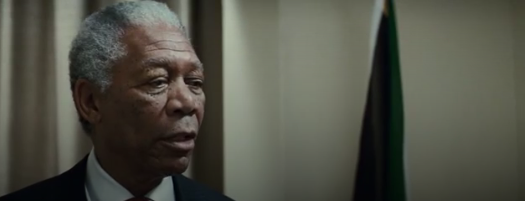
As this scene/ Mandela’s speech lifts the staff’s spirits and instills in them a shared vision for the country, the camera zooms in on Mandela’s face. The close up shot is sharply focused on his calm and determined demeanor/ face which occupies the left half of the frame, with the country’s flag in the background. This speaks volumes about the Mandela’s belief in himself and his country, that they would indeed eventually succeed at implementing something new.
*Mandela says “could not help noticing the empty offices” // “if you want to leave, that is your right” // “The past is the past. We look to the future now. We need your help. We want your help” // “… you would be doing your country a great service.” // “Our country will be like a shining light in the world”
Confrontation among the security guards
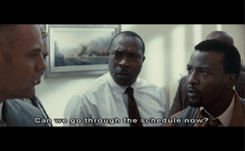

Eastwood utilises tight, close-up framing in this scene as to allude to the confrontation between black and white South Africans. By this, the director draws us in to the agitated, bemused expressions on Jason and Linga, who immediately clash with the new SAS bodyguards they must partner with. Jason stresses the personal bond between his team and the President – ‘[Madiba] that’s what we call him’. This immediately shows the distaste that the black South Africans have towards their ‘enemies’, the Afrikaners. (Source: https://www.vcestudyguides.com/blog/invictus-film-technique-analysis-how-can-i-write-about-it)
Springboks vs England

In this scene, Eastwood utilises wide, high angle framing to represent the enormity of the stadium; filled with Afrikaners who, predominantly, detest the new President. Still, even as the framing is constantly filled with these Springboks sports fans, the director shows us the smiling, confident Mandela, who warmly waves to his new ‘partners in democracy’ without fear or distaste.

We can see this as the camera draws in on Mandela’s facial expressions. Moreover, the courage of Mandela is exhibited as he exits the stadium and a sports fan hurls a drink at him. Even despite that he ‘sees everything’, Mandela continues to wave and smile at the crowd. (Source: https://www.vcestudyguides.com/blog/invictus-film-technique-analysis-how-can-i-write-about-it)
Mandela at the Springboks vs England game


Binoculars, as a prop, symbolize Mandela’s vision for South Africa. It also demonstrates his solution to reuniting the country: by focusing on rugby. Brenda’s glasses are utilized by Eastwood to representing clarity of vision.
The shot is tightly framed by Mandela’s binoculars. The audience members are positioned to look at the game from a narrow perspective, Mandela’s perspective. This shot emphasizes that the key to Mandela’s domestic policy is focusing on the Springboks, rather than being influenced and distracted by the chaos of the crowd.
Springboks vs England game

The team stands in the middle of the field during half time. With the crowd looking on and cheering, Pienaar desperately urges his team “come on okes, we need to focus! Focus! Focus!” to win their game against the English rugby team. In this scene, audience members are positioned to look up to Pienaar’s face due to the camera’s angle. Audience members are persuaded to view Pienaar as a heroic, charismatic, and capable team captain who has a strong desire to see the Springboks be victorious. Importantly, he has also set the direction and taught them the way to do it (Focus! Focus!). As the Springboks prepare to play the second half of the match, the camera tracks in an arc along the team’s huddle from the outside. Audience members understand two things. Firstly, Pienaar was in the middle of the group; the team captain must be in the thick of the action. Secondly, the Springboks demonstrate great unity; it foreshadows that this team will pave the way for the country’s eventual reunification.
Springboks played “without discipline, without strategy, and without courage” and lose to England

Eastwood demonstrates Pienaar as a prominent leader in the Springbok team. He is made out to be responsible for ‘[his] team’s’ dismal performance. Tight, close-up framing shows the audience a defeated Pienaar, a captain and leader who has brought ‘shame upon’ the South African nation, and as the rugby president suggests, deserves to ‘get the axe’. The harsh, low-key lighting of the frame draws in on the raked and bruised Pienaar, who is isolated as the key to the Boks having ‘their tails between their legs’ throughout the game.” Pienaar is personally affected by the team’s poor performance.
Outside the church


The wide shot that gives us a wide view of the slums subsequently tracks down to give audience members a more detailed view of the abject poverty the blacks live in. As our eyes follow the downward motion of the camera, we are literally and figuratively looking down on this community, we thus feel a sense of sympathy for them. As the camera pans to the right, the carefree children running around and the small business gives us a faint glimmer of hope.
Inside the church
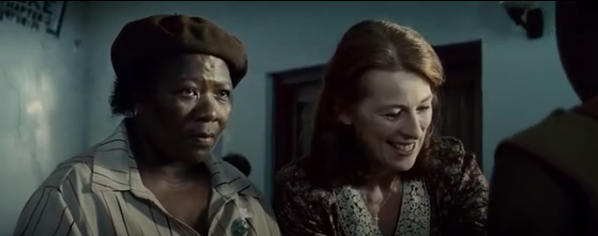

“You’re a very lucky boy!” / Sipho’s unmistakeable disappointment – even though he’s receiving charity items/ something for free, he refuses to take the jersey because “the Springboks represent apartheid” // clueless white woman (Why won’t he take it?) in contrast to the black woman + Sipho
At the National Sports Council

“All those in favor of eliminating those Springboks, raise your hand!” The establishing shot shows a crowded room in the midst of a meeting. Tensions are simmering as the NSC leader ignites resentment toward the Springboks and actively encourages the room to unite and destroy them. The dynamic and united action of the raised fist demonstrates solidarity; the disenfranchised blacks are finally ready to fight back against the whites. The atmosphere is charged with incendiary energy as they chant “Viva protest viva”
Mandela on his way to the NSC

Upon finding out about the NSC meeting, Mandela abandons the Japanese trade delegation to intervene. The tightly framed and closely shot scene features a camera tracking, moving in tandem with Mandela and Brenda as they converse. This walk and talk scene adds a sense of urgency to Mandela, characterizing him as a man on a mission. In this frame, Mandela is resolute and single minded in his focus to advise the NSC to make peace with the Springboks alone. He rejects all of Brenda’s advice and warnings. Even if he risks “alienating [his] cabinet and [his] party”, Mandela will intercede on behalf of the Springboks and stop the NSC’s plans.
Mandela disrupts the NSC meeting in style
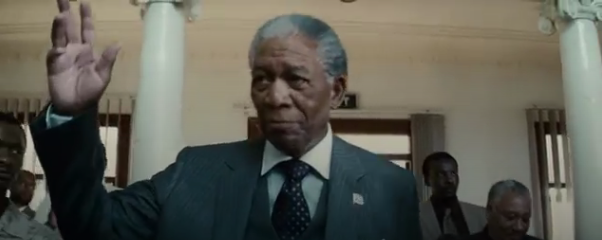


“Our enemy is no longer the Afrikaaner. They are our fellow South Africans, our partners in democracy… We have to surprise them with compassion, with restraint, and generosity.”
Camera angle positions audience members to look up to Mandela, which mirrors the respect, admiration, and awe the black South Africans have for their Madiba who has crashed their NSC meeting. This is a close up shot, featuring Mandela as the main focal point of this frame. Though he comes to the NSC Meeting with every intention to oppose popular opinion and overturn their vote to destroy the SB, he does so with confidence and a sense of calm.
Eastwood cuts to multiple establishing and medium shots of the same event, Mandela walking to the front of the room. Some from his perspective: camera tracks to the front of the room as the people clap and welcome him. Some are from behind his shoulder, enabling audience members to see him in the middle of the crowd, a popular leader.
After the NSC meeting

Mandela is once again on the move with Brenda his assistant. Brenda expresses concerns over Mandela’s strategy, a surrogate for all the people who doubted and questioned whether he would be successful at uniting the country (“You can’t keep interrupting affairs of state to placate the minority” // “I must.”). His sunglasses symbolically represent one of two things. Firstly, the sunnies represent Mandela’s view of equality, that he sees his country as being one color only. Secondly, the sunnies symbolize that all of his actions and decisions are tainted an excess of overly optimistic self-belief. Or is it practical cos looking into the light would hurt his eyes (damaged by the sun when he was forced to do hard labor as a prisoner on Robben Island)
The Springboks lose again; Pienaar’s line of inspiration

“I’d like to propose a toast to the taste of defeat. Drink it. Remember this and promise yourself never to taste it again”
Mandela makes various speeches

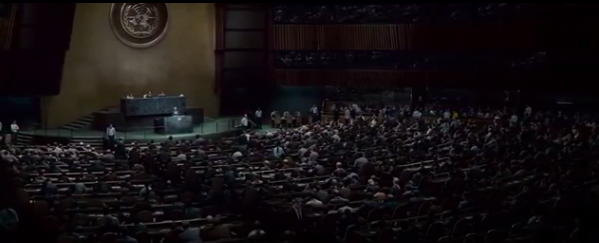

The medium shot from behind the official UN podium puts Mandela in the foreground, surrounded by a regal and somber green background. It places emphasis on the importance of Mandela’s words and ideas, not just to South Africa, but for the international community as well.
In contrast wide shot of the UN hall employs dramatic lighting to intensify the gravitas of the occasion. Mandela is in the spotlight on this occasion, giving rise to the impression that this is truly a significant and momentous event in the movie and in his career. Mandela is relatively small in comparison to the crowd here, yet his speech and voice is amplified loud and clear for everyone to hear.
Sudden cut to a different scene and completely different setting. This is now a speech taking place outdoors, with natural light. Mandela’s speech just goes on seamlessly despite the cuts – a comment on how relentlessly Mandela works to advance South Africa by making speeches in numerous countries to facilitate trade.
Inside the Pienaar household

The mise en scene of the Pienaar household is set up to be in contrast to the poverty of the South African projects. Eastwood utilizes establishing shots of the Pienaar living room to show audience members the details of how the white/black lives are different. This living room is totally enclosed, spacious and comfortable, with signs of conspicuous consumption everywhere. The pictures in frames hung up as decoration, the lamp that sits on a vintage wood cupboard to store their possessions, the sofas, the coffee table with a fruit bowl on it, the kitchen appliances, the electricity…
Mandela invites Pienaar to tea
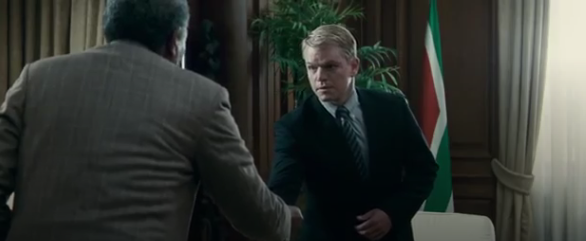

We see this from two perspectives as Eastwood cuts to two medium shots of the same event: firstly, from behind Mandela’s back. Pienaar receiving the cup of tea with a surprised expression and rigid, uncomfortable body language. Secondly, from diagonally behind Pienaar, where we can see Mandela extending the saucer to Pienaar. This camera work and symbolic gesture suggests equality between the two men.
*Mandela alludes to a poem and a song (African song)
*”We need inspiration, Francois. In order to build a new nation, we must all exceed our expectations.”
Pienaar goes back to real life


“I think he wants us to win the world cup”
Tight, close up shot of Pienaar and his girlfriend inside a stationary car. Pienaar looks awe-struck in wonder after tea with the president & receiving the mantle/role/task to lead the Springboks to victory at the world cup.
The Springboks have to hold training sessions in the projects

“We’ve become more than just a rugby team. You might as well get used to it.”
The medium shot has Pienaar in the middle of a confrontation with his team mates. He stands with his arms folded, facing off with the rest of his team. While Pienaar is resolute in following Mandela’s suggestion to hold training sessions in the projects as “times change, we need to change as well”. However, he is up against his team mates who vehemently disagree.
The springboks journey to the township


Eastwood cuts to multiple shots of the same event to highlight the differences in perception. In the initial establishing shot, the camera pans from the roadside as the Springboks’ bus drives past to highlight the setting. In contrast to the well maintained gym where the Springboks were training in earlier, this frame shows dilapidated houses. This shot is from the point of view of the poorer black south Africans in the township, the people who do not identify with the Springboks.
Subsequently, Eastwood utilizes this shot from within the Springboks’ tour bus to depict the Springboks’ journey into the township. This establishing shot is framed from behind the window of the bus to heighten the sense of alienation from the team’s point of view. The Springboks are the outsiders, this experience for them in the township is one that is foreign. The lighting is deliberately dull and somber to reflect the team’s lack of enthusiasm to be in this unpleasant town.
Springboks meet the boys in the township


“Who wants to play rugby?”
This wide shot depicts the barren land where the Sprignboks play rugby with the children in the township. Music plays (Shosohloza) over this scene where the relationships between the Springboks and the children. We also get to see the back of a sign, but Eastwood only reveals what this sign says at the end of this scene.


The Springboks and the township children stand together in the middle of the field as the camera pans from the inside and tracks in an arc from the outside. Audience members see the unity and togetherness of previously estranged communities, which demonstrates that Mandela’s vision is becoming a success. This parallels the scene from the first Springbok vs England game team huddle.
Mandela working in his office

Mandela is depicted all alone in his library, writing the poem, Invictus. The lighting is used to deliberately illuminate only Mandela from his side, depicting him with dignity and nobility. In contrast, the rest of the room is very dimly lit or in the shadows, and viewers can only see that Mandela is surrounded by bookshelves and books. The music that plays (9000 Days) starts playing in this scene, and carries on playing after a cut to the next scene to function as a linking device.
Springboks train for the world cup

This wide shot depicts Pienaar leading his team in a run. As he is in front, this portrays how he has guided and steered his team to work hard to win the final. Viewers are encouraged to see Pienaar as a team captain who is also a man of action. Though the viewers cannot see the other pedestrians on the street, we can hear cheering off-screen for the Springboks.
Pienaar’s proposition

“We need to learn the song. We can’t just mouth the words anymore.”
This establishing shot depicts Pienaar having a team meeting with the Springboks. As he tries to convince them to learn the South African anthem God Bless Africa, he is framed standing with his team mates who disagree with him.
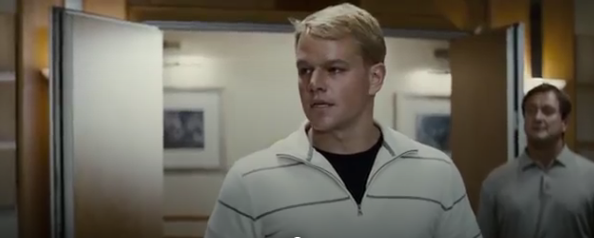
As the scene goes on, the camera zooms in and focuses on Pienaar’s face. This is symbolically representative of how he is championing a new idea, and facing fierce opposition. He concedes that learning the anthem is optional.
The Springboks visit Robben Island


This establishing shot focuses on the prison bars from outside the prison. In this shot, Eastwood frames Pienaar’s face with the bars. His face is rendered very small and in the shadows, almost as if he’s being caged in.
In this tightly framed, close up shot, Pienaar reflects on Mandela’s time in prison. This also symbolizes how Pienaar is also being imprisoned by Mandela’s and his country’s expectations for the upcoming world cup. The small enclosed setting is uncomfortable and stifling, perhaps a reflection on Pienaar’s role as team captain? Sound: Mandela’s voice reciting the poem, Invictus.
Flashbacks


“I am the master of my fate, I am the captain of my soul”
The camera pushes in on the faces of these two leaders. As Pienaar spends time on Robben Island, Eastwood cuts to flashbacks of Mandela doing physical labor mining for limestone. Significance? Lighting?
Mandela collapses

“He needs complete rest.”
This scene emphasises Mandela’s vulnerability and precarious health condition. The harsh lighting creates a dramatic contrast between light and dark. It illuminates only the pavement, leaving Mandela and his guards in the shadows. This is a comment on the uncertainty and danger that Mandela is in, viewers are encouraged to be shocked and concerned for this beloved leader.
Springboks watch the All Blacks vs England

“I will break my arm, my leg, my neck, but I will not let that freaking guy go.”
The security guards play rugby
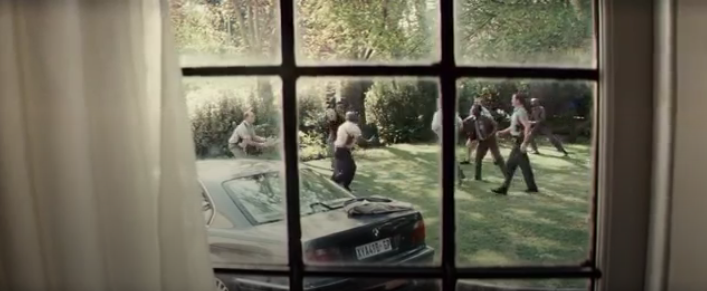
This establishing shot is framed from behind a window, this is from Mandela’s perspective. As this is the field in front of Mandela’s office, it indicates how Mandela stresses unity from within his own team, just as he aims to reunite South Africa. Leading by example, being a man of action. This also proves that Mandela is not wasting his time by focusing on rugby.
Springboks in the rugby final

On the other hand, this scene, whilst it continues to demonstrate the steadfast, affable nature of Mandela, shows the unification of South Africa. Through Mandela’s support of the Springboks by wearing the green and gold, we can understand that the Springboks have subsided from once being a ‘prominent symbol of the apartheid era’. By contrast to his first appearance, Mandela is now upheld as a leader to all; there is no jeering or booing, but lively backing of both the Boks and The President. Mandela has fundamentally transformed the team who once brought ‘shame upon our nation’ into something to be proud of and excited for.
The camera pans around the stadium depicting cheering and applauding fans, who are even carrying the new South African flag. Even more interestingly, the black South Africans who widely scorned the Springboks, are now watching the rugby final in support of their team; their country.
(Source: https://www.vcestudyguides.com/blog/invictus-film-technique-analysis-how-can-i-write-about-it)
The South African National Anthem

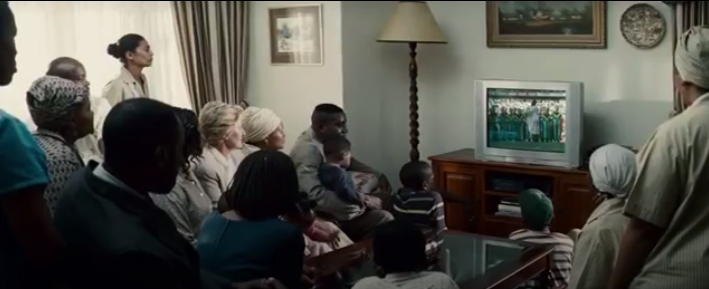






As the stadium sings, Eastwood cuts to the anthem being played. With this song in the background, different groups of people are depicted observing the national anthem. The Springboks playing in the world final is an important national event, everyone regardless of their age or class or ethnicity or location is focusing on it.
Pienaar and the team huddle



“We must disrupt them in the first phase. We can’t allow them to get the ball alone in space.”
Pienaar takes the lead and tells his team the strategy to win the All Black team. Initially Pienaar is seen with the stadium and some of his team mates listening attentively to his instructions. By the end of this team huddle, the camera pushes in on Pienaar’s face.
The game goes into overtime and the All Blacks missed their shot

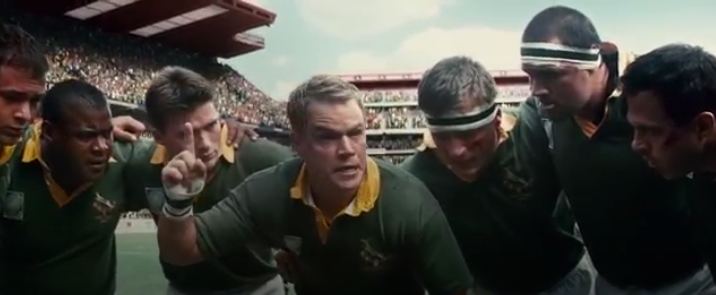

“This is it. This is our destiny!”
Pienaar holds a final team huddle. Music in the background: some south African song?
As Pienaar concludes his inspiring speech, the camera pushes in on Pienaar’s face. This not only emphasises the emotional quality of his words and how it’s pushing the Springboks on to victory. It allows viewers to see visible signs of how intensely challenging the game is. The blood trickling down his face is a symbol of his effort and sacrifice.
The Springboks have one final chance to win the game

Eastwood pairs emotionally evocative music and slow motion depicting the last shot in the final minute of the world cup final. This stresses the heroism and creates a sense of high anticipation in the most crucial part of the game.
The Springboks win & everyone celebrates

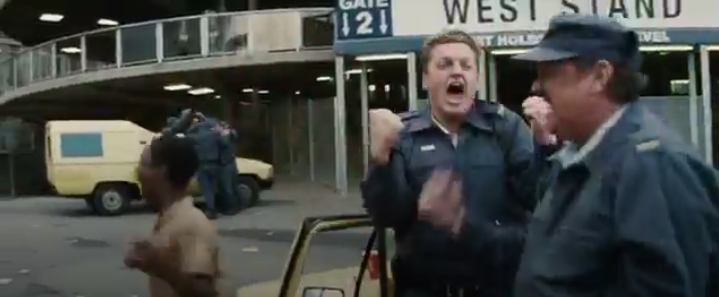





Eastwood uses quick cuts to depict different groups of people celebrating this historic victory. Exuberant atmosphere, joyful and celebratory.
The celebration continues

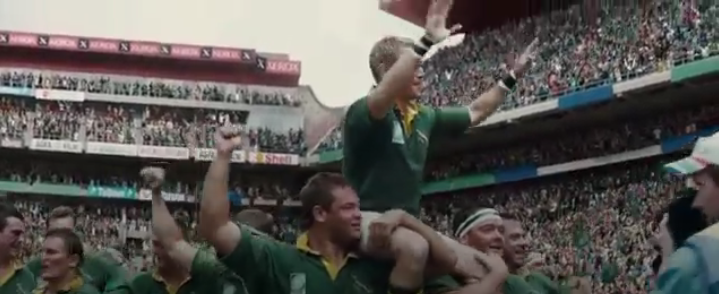
Eastwood portrays victory through using low angles to depict the respective leaders. Viewers are encouraged to look up to them and perceive them as respectable people.
Lighting: Sunlight shining through the stadium to set the tone of optimism, that with self-belief we can achieve the impossible.
The trophy

“We had the support of 43 million South Africans”

Mandela passes the trophy to Pienaar (repetition of the tea scene?)
The end

“I am the master of my fate, I am the captain of my soul”
this quote seems more aimed at human captors and internal despair. People may imprison you unjustly; they may kill friends and family. But they cannot conquer your soul.
(Source: https://www.patheos.com/blogs/christandpopculture/2009/12/invictus-showcasing-the-power-of-leadership-forgiveness-and-hard-hitting-rugby/)
#likeaboss
Camera movements:
- Zooming, panning/tilting, tracking, hand-held
Mise en Scene: the arrangement of a frame; the artistic look of a shot in its elements of lighting, colour, camera techniques, sets, costumes, etc.
Lighting:
Hard light (harsh): sharp contrast that create distinct and shadows. Effect: feels dangerous, mysterious, moody, portrays the character as threatening, or trapped somehow, and maybe the situation is tense
Soft light (gentle): gradual shadows with softer edges. Effect: inviting, warm, friendly, portrays the character as honest, trustworthy, familiar
Light can orient the viewers, giving them clues about the setting and time of day
-soft gentle light of dawn or the harsh direct light of midday
-warm light: hot sweaty summer or cool light: cold dull winter
Lighting can evoke a mood or atmosphere and allude to how viewers should be feeling in any particular moment in the movie
-are we looking at harsh street lights that cast dangerous shadows as the characters move around in a shady part of town
-or are we walking along a familiar city side walk with warm and inviting lights spilling out from neighbours windows
-is the smoky light in a dimly lit jazz club emphasizing the dazzling leading lady on stage
-or is the stark and direct spotlight on a large theatre stage making the actor feel trapped and isolated & the room dark and tense?
It can characterize the actors, depicting them in a flattering and beautiful light to express their kindness, honesty and altruism. In contrast, lighting can obscure parts of their face to paint them as a mysterious, enigmatic character to increase the suspense.
Warm lighting may suggest joy, love, optimism, nostalgia, the growth of a romantic relationship. In contrast, cool lighting may suggest detachment, depression, and stagnation.
Front light (flat light no shadows; “neutral”)
Front light from a height (beauty light, romantic, mimics how we typically see people in real life. It is usually reserved for safe, comfortable and familiar characters.)
Top light (like the bohemian rhapsody video, lots of shadows, obscuring a lot of the face incl eyes. No eye contact, shadows are covering the character’s eyes, making it difficult for viewers to connect with the character or understand their intentions. It’s frustrating, isolating…)
Under lighting (like telling a ghost story illuminating all the face, shadows are cast upwards. Shadows are seen in parts of the face that seem unnatural to us, so it transforms the character into one that’s unsettling, scary, or dangerous))
Side light (half of your face is in shadow and half is in the light, conflicting!)
Edge light (one small edge, and small details of your actor is defined, but everything else is in the shadows)
Back light (separation between subject and background)
Lighit = control over what the viewers see or don’t see.
Point-of-view: the perspective from which the text is portrayed; the audience are driven to identify with characters portrayed.
Opening/resolution: how a narrative is introduced in setting up characters, settings, etc., how these develop and resolve at the end of a text.
Motif: a distinguishable feature which portrays a theme and idea about a character, setting, etc.
Visual symbols/ visual metaphors
Sound:
diegetic were we can see the source of the sound, non-diegetic were we can’t see the source of the sound, ambient which is all the background sounds that could highlight the location i.e. birds singing, waves, cars or even wind, we also have sound effects this is sound that has been added in,
The title is Latin for “unconquerable” and also references the poem from a famous British writer William Ernest Henley.
“I am the master of my fate: I am captain of my soul.” These words form the heart of “Invictus,” the poem by William Earnest Henley and the title of Clint Eastwood’s new film. The poem comforted and renewed Nelson Mandela as he suffered imprisonment from 1964-1990 in Apartheid South Africa. The fall of Apartheid led not only to his release but his eventual election to the Presidency in 1994.
Invictus the film focuses on Mandela (played by Morgan Freeman) and Francois Pienaar (Matt Damon), the captain of the Springboks, South Africa’s rugby team. Once hated by blacks in South Africa as a symbol of white oppression, now disdained by whites for their poor performance on the field, the Springboks’ play in the 1995 Rugby World Cup becomes an unlikely opportunity for Mandela to seek unity in racially torn South Africa.
Clint Eastwood notches another success with Invictus, which uses a rugby championship as a means for examining South Africa’s transition from apartheid. Based on real-life events and told with deceptive simplicity
Invictus is a movie of ideas more than events
Not only are the odds against the Springboks very clear, but each gesture by the players, Mandela and his followers is weighted both with hope and expectation and with the fear of failure.


Leave a Reply
You must be logged in to post a comment.